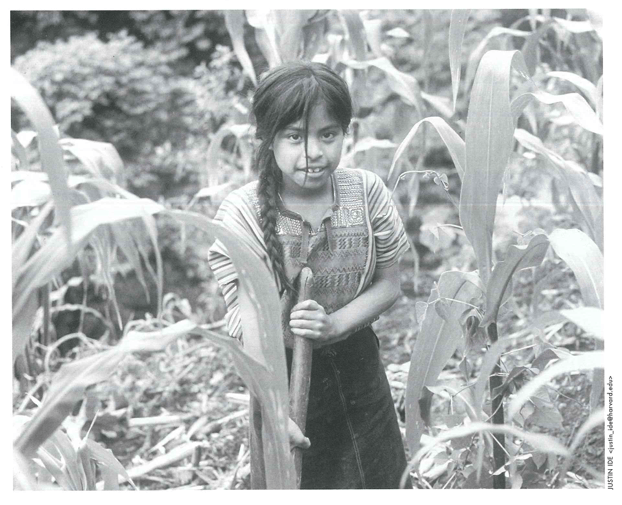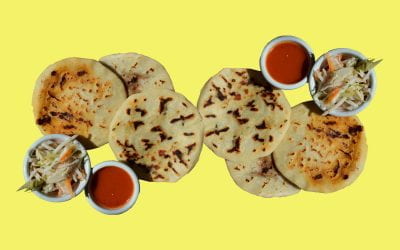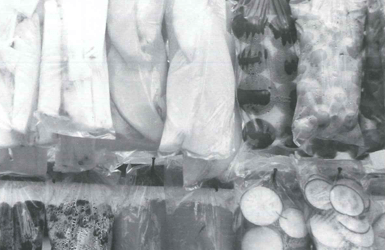Rigoberta Menchú and the Politics of Food

A Mayan girl in traditional dress amidst Guatemalan corn.
I think everyone who reads Rigoberta Menchú’s famous 1982 testimonio remembers the part in editor Elisabeth Burgos’s prologue when she describes how she won the Guatemalan woman’s trust by preparing food together. From Venezuela Burgos had received corn flour and black beans, and had preserved some cayenne peppers in oil. Corn, chile and beans were also the staples of Guatemalan cuisine, and the young Rigoberta, far from home in Paris, was elated to partake of some “soul food:” I cannot describe how happy that [food] made Rigoberta. It made me happy, too, as the smell of tortillas and refried beans brought back my childhood in Venezuela, where the women get up early to cook arepas for breakfast….`We only trust people who eat what we eat,” she told me one day …[and] I suddenly realized that she had begun to trust me. A relationship based on food proves that there are areas where Indians and non-Indians can meet and share things: the tortillas and black beans had brought us together …”
The food exchange between these two women is interesting in several ways. It serves as a “marker of ethnic identity via ethnic cuisine,” as anthropologist Ellen Messer terms these interactions in the Annual Review of Anthropology 1984, yet there are also profound differences in how this food functions for each woman. In the narration, there is a clear difference of class. From her earliest childhood, Rigoberta rose early each morning to grind corn and make tortillas, Burgos speaks of other women getting up to make arepas when she was a child. In retrospect, I am surprised that Burgos an ethnologist and experienced leftist activist who had traveled widely in Latin America told this story so ingenuously. In A Dream of Light and Shadow, critic Mary Jane Treacy interpreted this episode quite differently. She classified Rigoberta as a “skilled organizer … and a savvy politician who uses foreign intellectuals and presses to help [her] cause. So although her interlocutor and editor Elizabeth Burgos could fall into reveries of a Venezuelan childhood as she watched Rigoberta make tortillas in her Paris home, we can bet that Rigoberta knew exactly why she was in France telling her life story to a woman with excellent international connections.” From the prologue on, then, food and politics is a dominant theme in Menchú’s testimonio, and food discourse is a productive frame for analyzing this text.
Before proceeding any further, however, it is important to note that testimonio itself is a very slippery genre. Menchú told her story to Burgos, who taped, transcribed and edited it, so that we are always reading a mediated text. The matter becomes even more complicated with recent revelations that Rigoberta herself may not have lived all of the experiences she relates in her testimonio. The impact this may have on the reader is something I will return to later.
Burgos is not the only one who is seduced by sharing food with Rigoberta: most readers are as well, as food functions on so many levels in our lives and experiences. Whenever I introduce the subject of food into my classroom lectures, students’ eyes come into focus, slouchers sit up and there is instant attention. Food as a trigger of affective memory is well-known, as is its role as definer of cultural identity. Rigoberta’s food discourse functions on both fronts, which is what makes it both memorable and effective.
Once the prologue is over and Menchú takes over the narration, the reader immediately becomes aware of the central importance of food in her people’s lives, mainly because of its constant scarcity. Rituals of food are both elaborate and rigidly prescribed. As culinary historian Margaret Visser noted in The Rituals of Dinner, each culture chooses food preparation and consumption to reflect “the most appropriate to handle the mightiest of necessities, the most potent of symbols, the medium through which we repeatedly express our relationships to each other.” Rigoberta describes rituals of food preparation very fully: women blow on their hands prior to making the basic corn/lime mixture, the nixtamal; they whip clay pots to make them resistant; grinding stones [metates] are given with them in marriage; water and wood are blessed. The process of grinding corn for tortillas was an especially arduous and time-consuming chore. Menchú saw this in the life of her own mother. When the family went to harvest coffee to supplement their income, Rigoberta’s mother also took on cooking for about forty workers; to do this she got up at three in the morning to grind the corn, and worked until seven at night, while also providing for her own children and picking coffee. Observing her mother’s backbreaking work schedule awakened the child Rigoberta to the conditions in which her people lived: “Watching her made me feel useless and weak because I couldn’t do anything to help her except look after my brother. That’s when my consciousness was born.” (34)
Rigoberta is adamant about using only natural products, and in preparing food in traditional ways. She urged her people to avoid machine produced ladino (non-Indian) foods, such as cheese, ham and Coca Cola, because “The ladinos bring their machines in little by little and very soon they own everything.” (72) Rigoberta’s instincts are well-founded: studies show that the mechanization of corn tortilla production in Mexico and the consumer shift to flour tortillas and bread have certainly had deep social repercussions. Making bread is far less labor-intensive than making tortillas, but Rigoberta was averse to bread. She objected to it neither because of its taste, nor because of the cultural corn/wheat opposition in Mesoamerica, but because the whites mixed wheat with eggs. Bread to her is a metaphor for a contaminated mestizo culture: “It was a mixture, no longer what our ancestors ate. It was White Man’s food, and white men are like their bread, they are not wholesome. The blood of our most noble ancestors was mixed with the blood of white men. They are a mixture, just like their food.” (71)
Besides Rigoberta’s experiences on the coffee plantation, her stint in the city, working as a domestic servant for a ladino family, was another formative experience in shaping her conscience. She cited her lack of Spanish as a prime factor in making communication with her employers difficult, but she had no trouble deciphering extraverbal signs which indicated her place in their culture. Nowhere did she feel this more keenly than in the family’s rituals of eating: “When I saw the maid bring out the dog’s food bits of meat, rice, things that the family ate and they gave me a few beans and hard tortillas, that hurt me very much. The dog had a good meal and I didn’t deserve as good a meal as the dog”(92).
At Christmastime, she and her señora had stayed up an entire night making two hundred tamales for a family party, but in this instance shared food preparation did not bring the women closer. Near the end of the party the señora had given Rigoberta one tamal, but when some late arrivals showed up, the señora took it back to feed her friends. For Rigoberta, this was the last straw.
After this episode Rigoberta became much more politically aware. Another negative food experience with ladinos heightened her rage at her people’s powerlessness in the social and political processes of Guatemala. The peasants had by now organized to protect their lands against the claims of the landholders, but needed the help of ladino lawyers and engineers: “[The engineers] were ladinos. They couldn’t eat our food, our tortillas with salt. If we didn’t feed them well they would probably favor the landowners. So we treated them very well, out of fear. We gave them our best, our fattest animals …. Our community, which never bought so much as a bottle of oil, had to buy them rice, oil, eggs, chickens, meat. We had to buy coffee and sugar, because they couldn’t eat panela. Our community never ate these things.” (104) She has set up a dichotomy between certain foods that is clearly political as well as ethnic: bread vs. tortilla; coffee vs. water or maize drinks (pinol, atol); refined sugar vs. panela. Similarly, when General Kjell Laugerud began his electoral campaign in 1974 he promised the peasants land and bread in return for their vote. Rigoberta was indignant: “Kjell talked a lot about giving us bread and sharing out the land. They have to say bread, they can’t even say tortilla. Most of them don’t [even] know what Indians eat.” (157). When war broke out and the indigenous population armed itself against government soldiers, women even used food as weapons: boiling water, lime, chili, and salt, which they would throw into the soldiers’ eyes.
Critics have commented on the way Rigoberta availed herself of the Bible when it suited her needs, adopting that which was useful to her cause. Her definition of Heaven is very simple: “… the kingdom of God on earth … will exist only when we all have enough to eat, when our children, brothers, parents don’t have to die from hunger and malnutrition. That will be the `Glory, a Kingdom for [us] who have never known it.” (134) She couched her fight against the Guatemalan government and imperialism in the same terms: ” … it is a struggle which cannot be stopped. Neither the governments nor imperialism can stop it because it is a struggle of hunger and poverty. Neither the government nor imperialism can say: “Don’t be hungry, when we are all dying of hunger.” (135)
Some of the most tragic parts of her testimonio concern the violent deaths of her father and mother, both at the hands of the Guatemalan government. Rigoberta wrote eulogies about them both. She recalled her mother’s many political discussions while helping other women make tortillas, but wrote a longer statement about her father, to whom she had always felt closer. After Vicente Menchú died Rigoberta reflected on a happy time she had spent with him some years earlier. During a serious food shortage, her father took her and some of her siblings to another Indian village in a more tropical region three days from their home. At first Rigoberta thought she had found Paradise: “This village was wonderful, because everyone had bananas in their gardens. Everyone had a lot of crops: bananas, plantains, yuca, maize, beans, ayote, chilacayote [squashes], all the things that grew there. There were so many things, there were things to spare.” (191) There was a lovely river, with large smooth boulders, but the place was not as much of an Eden as it initially appeared. Poisonous snakes dwelt among the stones on the river banks, and, on closer inspection, Rigoberta discovered that the children, who had worms and distended bellies, suffered from malnutrition, mostly because their diet was almost exclusively bananas. Rigoberta concluded that this community’s problem was that it did not eat corn (the corn crop was taken by the local landowner): “And we realized the value of our maize, the value of our lime. That is why, as our ancestors said, it is so sacred. It is true that without maize, without lime, a man has no strength.” (193) She now understood even more clearly her people’s respect and reverence for corn.
As Rigoberta became more actively political, she realized that she had to learn to communicate with other ethnic groups, so she learned three other indigenous languages, as well as Spanish. She realized what truly united her people: “I discovered that all Indians have a common culture in spite of the linguistic barriers, ethnic barriers and different modes of dress. The basis of our culture is maize.” (169)
Rigoberta’s roots in her “culture of maize” go much deeper than simply preferring tortillas to bread, and much of her aversion to changes in food preparation and eating habits was a conscious tactic in a cultural and political resistance that dated back to the European conquest of Mesoamerica. As Ellen Messer noted, “Food can … serve as a vehicle of `gastropolitics’ which enables one to protest one’s position or communicate one’s dissatisfaction of the status quo….”
Food as a persuasive narrative strategy in Rigoberta’s testimonio is thus an effective device both in eliciting reader sympathy, and in framing the story of her evolution from an illiterate Guatemalan Indian woman to a skilled and powerful activist. However, the recent disputes about the authenticity of her personal experiences certainly alter the way we read her words today. Does it really matter if some of the events happened to others and not directly to her? Critics are sharply divided on this point. Daphne Patai feels that ” Rigoberta Menchú is not admired as a creative writer. She is admired as the embodiment of a certain struggle. For her to be compromised is not okay, anymore than if we found that the diary of Anne Frank was written by her father.” (Chronicle of Higher Education, 1/5/99) David Stoll, the anthropologist who revealed factual flaws in her narrative in Rigoberta Menchú and The Story of All Poor Guatemalans, nevertheless points out, “Even if it is not the eyewitness account it claims to be, that does not detract from its significance …. Even if the life told is not particularly her own, even if it is a heavily fictionalized heroic life, she achieved what she intended in a way that one person’s actual life never could.”
So what is the reaction of the reader who has identified in a strong emotional way with Rigoberta’s tragic story, especially with the parts which dealt with food? Stoll relates that Rigoberta most likely never accompanied her mother to the coffee plantation because at that time in her life she was being educated in Spanish in schools run by Belgian nuns (159-162). This fact subsequently undermines her story of being victimized by the ladino señora because of her lack of Spanish. When I teach this text I purposely let the students read Rigoberta first, and then present them with Stoll’s text. They are almost uniformly shattered. I think Rigoberta’s readers are so affected by these revelations because we are dealing with a double loss of innocence: Rigoberta’s presumed innocence as narrator, and certainly the innocence of many a reader, including me. As Menchú had said to Burgos: “We only trust those who eat what we eat.” How to rebuild the trust?
I think the answer to my dilemma was ultimately both complicated and simple. While at a conference of the New England Council of Latin American Studies at Yale in the fall of 1999 I had sat in on another heated discussion in an attempt to clarify my position. For two and a half hours some 150 academics went mano a mano on the subject, until someone finally asked, “Are there any Guatemalans here?” One man stood up. “What do you think?” he was asked. He answered, “Lo que le pasa al vecino le pasa a uno” (“What happens to a neighbor happens to you”), and sat down.
Maybe it’s time to break out another ration of beans, chiles and tortillas and forge a renewed relationship with Rigoberta’s story.
Spring/Summer 2001
Nina M. Scott is Professor of Spanish and Graduate Program Director in the Department of Spanish and Portuguese at the University of Massachusetts/Amherst. She hosted Rigoberta Menchú’s 1985 visit to Amherst. Her most recent book is a bilingual anthology of early Spanish American Women Writers: Madres del Verbo/Mothers of the Word (U of New Mexico P, 1999). She is currently planning a new course on “Food and Discourse” for Fall 2001.
Related Articles
Salvadoran Pupusas
There are different brands of tortilla flour to make the dough. MASECA, which can be found in most large supermarkets in the international section, is one of them but there are others. Follow…
Salpicón Nicaragüense
Nicaraguan salpicón is one of the defining dishes of present-day Nicaraguan cuisine and yet it is unlike anything else that goes by the name of salpicón. Rather, it is an entire menu revolving…
The Lonely Griller
As “a visitor whose days were numbered” in Buenos Aires, Argentina, he tossed aside dietary restrictions to experience the enormous variety of meat dishes, cuts of meat he hadn’t seen…



